 I have used rifles in calibre .458 Lott on seven African safaris, where I shot plains game (impala, hartebeest, oryx, kudu, eland, and warthog) as well as big game (hippo, buffalo, and elephant).
I have used rifles in calibre .458 Lott on seven African safaris, where I shot plains game (impala, hartebeest, oryx, kudu, eland, and warthog) as well as big game (hippo, buffalo, and elephant).
Based on my own experiences, and on numerous comments and reports published in the hunting literature, the .458 Lott seems to be ideally suited for African hunting because of its high efficiency and penetration.
Another major advantage of the Lott is that almost every supplier offers .458 bullets in various weights. Before the Lott was CIP-regulated a few years back, you had to load your ammunition yourself. However, both Norma and Hornady now offer cartridges in this calibre, and more and more suppliers are producing affordable rifles.
Bigger cartridges in the .500 class and upwards may offer more power, but the downside is they come in very heavy rifles weighing 12 pounds (5.4 kg.) or more. In comparison, .458 Lott rifles usually weigh around 9.5 pounds (4.3 kg.).
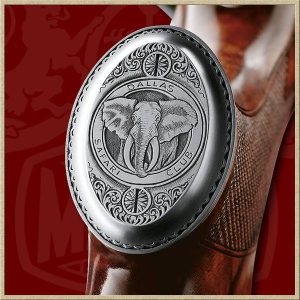 If you are not an Olympic decathlon competitor, you will be glad that the rifle you have to carry all day is not too heavy. In this respect, the .458 Lott offers an ideal compromise between portability and power.
If you are not an Olympic decathlon competitor, you will be glad that the rifle you have to carry all day is not too heavy. In this respect, the .458 Lott offers an ideal compromise between portability and power.
Another advantage of the .458 Lott is that it is not only useful on big game; it also excels on plains game. While it is not possible—or only in a very limited way—to upload small calibres, you can always download a big bore. For instance, you can download the .458 Lott with 400 grains bullets to the level of a .416 Rigby, and with 300 grains bullets to .375 H&H performance. (Some .458 Lott loading data is given below). In other words, you can use the .458 Lott for the whole spectrum of African game from elephants down to small antelopes.
Shooting game with the .458 Lott sometimes seems to attain an almost magical quality: you point your rifle at the

game, pull the trigger and down it goes as if a photon torpedo from the Starship Enterprise hit it.
My .458 Lott rifles
Back in 2000, I bought my first .458 Lott rifle. It was a Blaser R93 converted by a custom maker. Later on, I had a complete custom .458 Lott rifle built on an old (pre-WWI) DWM model 98 lock. This rifle featured a 23-inch Lothar Walter barrel with a laminated wood stock.
Mausers M03
For the first time, I held the new Mauser M03 in my hands during the 2005 hunting fair in Dortmund, Germany. I was surprised by how well the rifle balanced. That is something almost everybody mentions
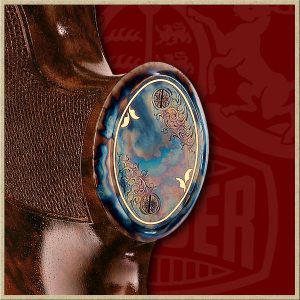 when they handle the rifle. When you take the M03 to your shoulder, it almost naturally lines up to the target. That is probably due to the classic styled straight comb of the “English type” stock. The stock has an ebony forearm tip with very fine and crisp checkering.
when they handle the rifle. When you take the M03 to your shoulder, it almost naturally lines up to the target. That is probably due to the classic styled straight comb of the “English type” stock. The stock has an ebony forearm tip with very fine and crisp checkering.
Mauser’s so called “hunting bolt action rifle M03” is available in a large range of interchangeable calibres. The basic model comes in calibres from .222 Remington up to 9,3×62. The M03 model “Africa” is offered in calibres .375 H&H, .404 Jeffrey, .416 Remington, and .458 Lott. An interchangeable calibre means that for instance, I could exchange my .458 Lott barrel against a .222 Remington barrel. To do this, I would just need the new barrel and another bolt head for calibre .222 Remington.
The M03 features a manual cocking system, a detachable magazine (4 shots in cal. 458 Lott), and six large locking lugs. The rifle can be taken down for transport. The M03 is an “all steel” rifle, i.e. not only the barrel but also the receiver, the bolt, the bolt head, and the magazine are manufactured from steel. These attractive features motivated me to buy this rifle. Let’s have a look at the M03 in more detail.
Manual cocking system
The M03 has many innovative features. What comes to mind here first is the new Mauser manual cocking system. There is no safety catch; instead, you have a cocking device. You can carry the rifle uncocked, with one cartridge “up the spout”. This is totally safe, there is NO possibility that the Mauser could accidentally fire in this mode.
 In this picture, you see the cocking lever in the left “S” (safe) position. Prior to shooting, you cock the rifle by pushing the horizontal cocking lever from left to right.
In this picture, you see the cocking lever in the left “S” (safe) position. Prior to shooting, you cock the rifle by pushing the horizontal cocking lever from left to right.
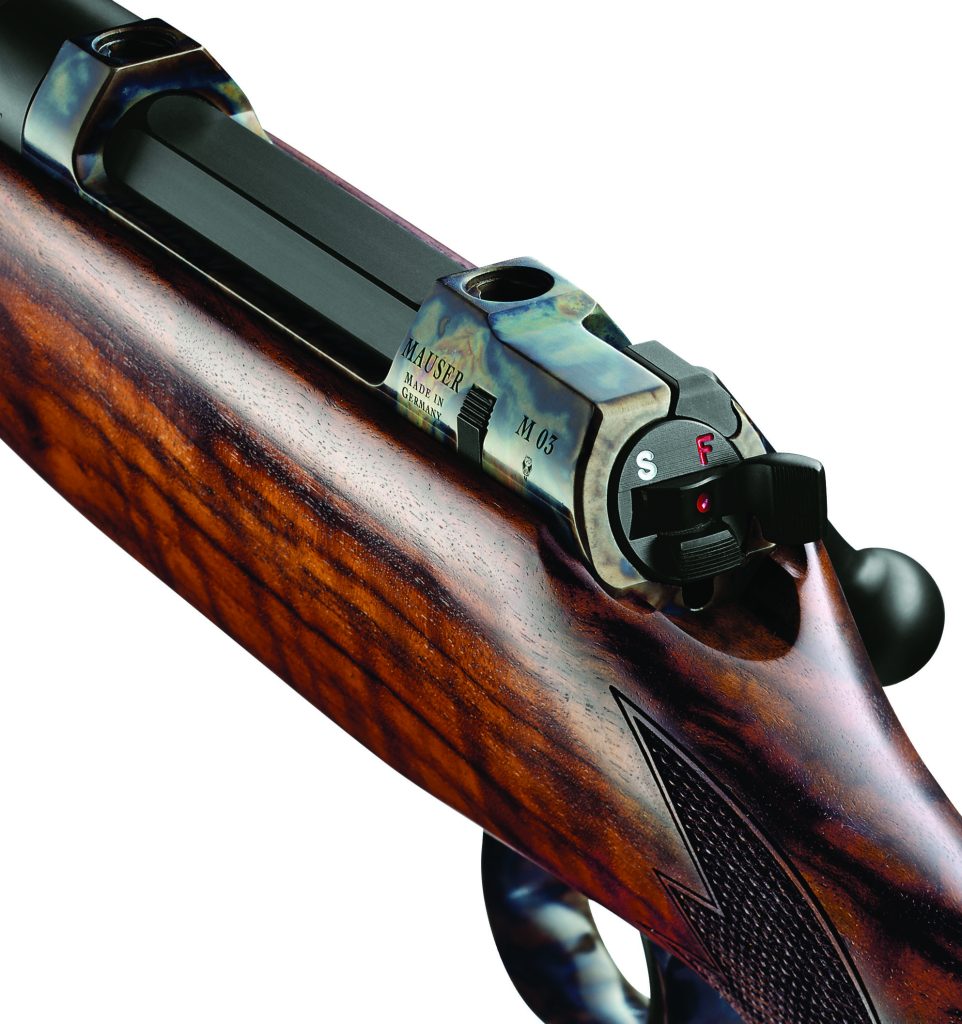
In this picture, you see the cocking lever in the left “F” (fire) position. When you cycle the lock after shooting, the rifle is automatically cocked again. To uncock the lock, you push the little rectangular button that is under the cocking lever. The cocking lever then moves back into the safe position.
Take Down Feature
The M03 is a “takedown” rifle. The barrel is bedded into a solid piece of steel. First, you have to remove the bolt. Then you loosen two Torx screws. After this, you can take out the barrel. Stock length (length of pull) can vary between 34.5 cm and 38.5 cm. (13.6 – 15.2 in.).
My rifle has a nice walnut stock with straight grain. There is also a synthetic stock available with black, nonslip ‘elastomer’ inlays. It is understood that for use in Africa a synthetic stock is much more practical than walnut. Nevertheless, when I bought my M03 in 2005 the synthetic stock was not available, so I had to take the walnut stock.

The stock with a length of around 80 cm. (31.5 in.) is the longest part of the rifle. This means that the M03 fits into a short gun case which is very convenient if you are travelling with the rifle. I have taken down the M03 for cleaning or transportation and afterward, put it together again many times. Despite many repetitions of this procedure, the point of impact never changed at all.
Locking System
The bolt head locks directly into the barrel. The M03 has six large lugs directly inside the barrel, instead of two dual opposed locking lugs of the old Mauser M 98. This, together with modern steel, makes for a very strong locking system. The M03 has a short bolt lift of only 60°. This requires less arm movement and, together with a very smooth feeding, speeds up the loading process.

The M03 does not have the old Mauser M98 type non-rotating long extractor. Instead, it has a spring-loaded plunger ejector and the small hook-type extractor claw recessed into the bolt head typical for many modern rifles. Many of us have been somewhat brainwashed, believing that one is in grave danger and laying one’s life on the line facing dangerous game, if one’s gun has not the claw-type Mauser-style extractor. Presumably feeding with a push feed action is not as positive when holding the rifle sideways or upside down.
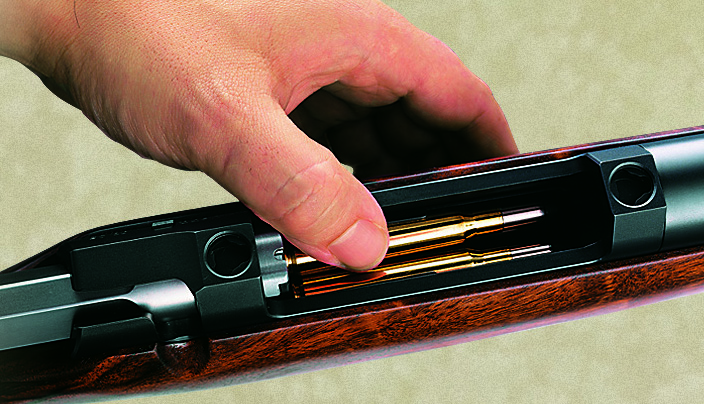
I have tried it out several times with my M03, holding it upside down or sideways, and never encountered any feeding problems. Boddington, in his new book “Safari Rifles II”, says on page 267 about comparing the push feed system with the Mod. 98 action: “Rarely is there a clear-cut disadvantage or advantage to either system, but it must be recognized that modern actions are stronger than any Mauser — and if an action is going to blow, a Mauser … or even a pre-64 Winchester will blow long before a … modern action”.
In the picture, you see the M03 bolt together with bolt heads, which would have to be exchanged if you would want to change to another calibre.
Detachable Magazine
The M03 has a detachable magazine of the double column type. In calibre .458 Lott the magazine capacity is four shots. The M03 can easily be reloaded from the top with the magazine inserted – or alternatively by exchanging the magazine.
Therefore, if you found yourself doing battle with an elephant cow herd, you could quickly drop the empty magazine by pushing the magazine release button in front, and insert another fully loaded four-shot magazine. Although admittedly not many of us will have to battle with enraged elephant cows, it still is a comforting thought that an additional magazine will give you so much firepower. For those who fear that they might inadvertently drop the magazine from the rifle, there is a magazine stop button, which prevents removing or losing the magazine.
Barrel and Sights
The barrel of the standard M03 Africa is 65 cm. (25.6 in.) long. I chose a barrel length of 60 cm. (23.6 in.) which makes the rifle handier. The barrels of the magnum calibres are quite heavy and strong; the muzzle diameter is 19 mm. (.75 in.)
The steel of the barrels is plasma nitrated. This means the barrels have a non-reflecting and fully rustproof surface. The sling swivel is barrel-banded because a standard, forearm-mounted sling swivel is not a not a good idea for a heavy rifle because of the damage you could do to your hand if it slipped forward under recoil.
The rifle shoots very precisely. Please see the three shot group below. The distance was 100 meters (109 yards) and the scope was set on 5X magnification.
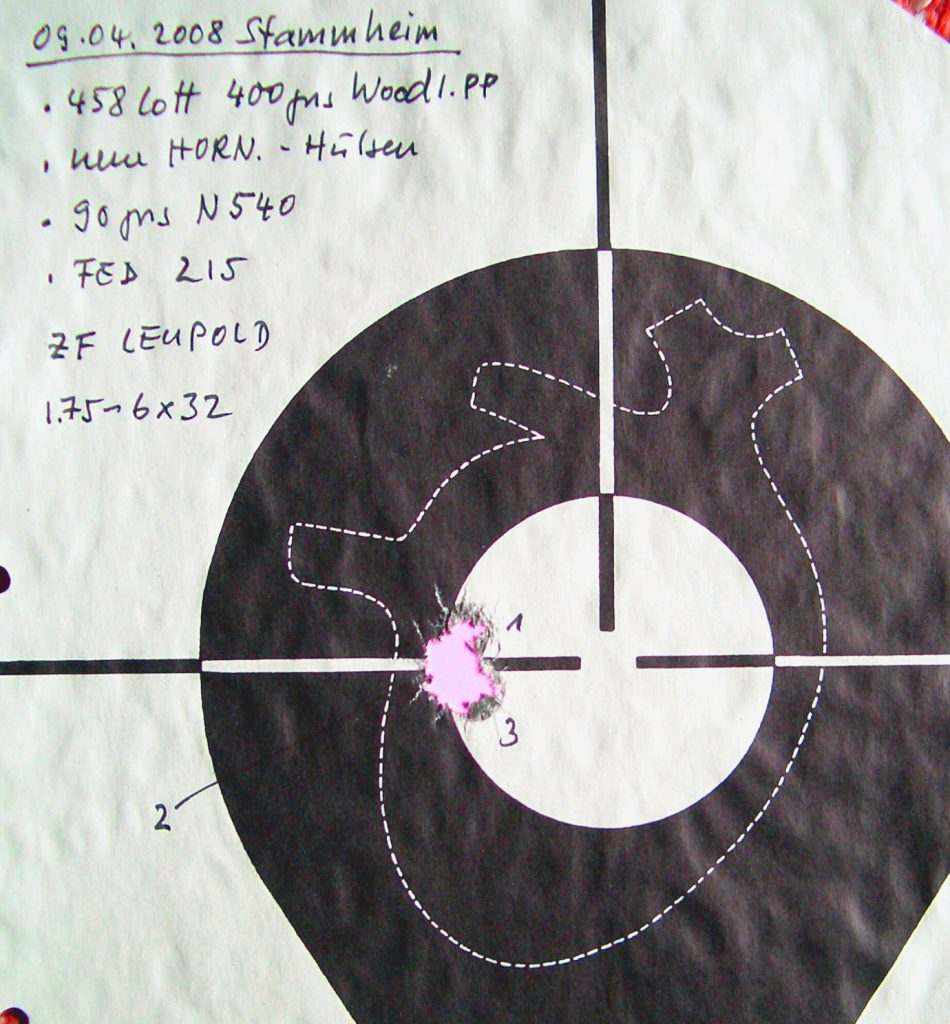
The rear sight is sideways adjustable.
The M03 has a barrel-banded, pearl, cupro-nickel, front sight, which is vertically adjustable.
The M03 has a very fast lock time, faster than MOD 98 locks. The trigger has a clean, crisp, shotgun-type release. A set trigger is available as an option. I myself hate set triggers; I do not need them and I feel that they are an abomination on a big game rifle.
Scope Mount
The M03 features a so-called double square bridge with integral scope mount bases.
Here you see a Swarovski scope mounted on a M03. I have installed a Leupold 1, 5 – 5 x 20. I am using this type of Leupold scopes on all my big bore rifles. The eye relief on these scopes is very long which helps to avoid a “Weatherby eyebrow”.
Leupold scopes are very robust and shock-resistant; they have never let me down during my African hunts. Walking through the bush I usually set the scope at a 1.5X magnification. This allows me to pick up game quickly, should the situation require this.
Rifle Weight
The rifle without cartridges and without scope weighs 4,3 kg. (9.5 lbs.). This weight may not seem much for a big-bore rifle. However, with five cartridges and the scope mounted, the total weight goes up to nearly 4,9 kg. (10.8 lbs) and dampens recoil sufficiently for most shooters.
Loading data for the .458 Lott
When I started using a .458 Lott, it was very difficult to find a proof house that owned a .458 Lott barrel. Then with the help of a friend, I contacted the Vienna government proof house.
This proof house in later years performed the CIP standardization and was very helpful in testing my ammunition. If you wish to contact them, their phone number is ++ (431) 734-6268. Please ask for Mr. Hallusch, as he is the specialist for the .458 Lott.
All the loads shown below were tested by Mr. Hallusch and released according to § 15, Abs. 2 of the Austrian proof law. All tests were performed with a 65 cm. (25.6 in.) test barrel. Of course, in my 60 cm. (23.6 in.) barrel, the muzzle velocity would be a few meters/sec lower.
Kemira N540 seems to be temperature stable. I never had any problems with these loads as a result of African temperatures.
An Unexpected Stress Test
In May 2008 I joined a Namibia safari organized by the “Deutsches Waffenjournal” (German Gun Magazine) and Mauser. The safari started with all the participants invited to sight in their guns on the rifle range. I had brought along 40 shots with 400 grains of Woodleigh PP (protected point) bullets. In the last years, I’ve shot with this type of cartridge a lot of plains game, mostly “one shot kills”; among those two Elands.
Thorsten Mann (Mausers CEO) got me 40 cartridges with 420 grains of monolithic solids from one of the smaller European hand loaders. To try them out I loaded five cartridges. The first 4 shots went into a nice tight group.
The fifth shot was louder and recoiling harder. The bolt lift was rather sticky. So I handed the rifle over to Thorsten and told him “… please look at it!” It turned out that the cartridge case was quite deformed. The primer was blown out of the primer pocket; the primer pocket was enlarged and in a kind oval shape. Egaad!! Excessive pressure!! Thorsten Mann and Walter Schultz (Waffenjournals editor-in-chief) are both gunsmiths.
They estimated the pressure to be around 7000 to 8000 bar (the max allowable pressure for the .458 Lott is 4300 bar = 62600 psi; 8000 bar = 116000 psi)!) Thorsten inquired whether I got some powder particles into my face or my eyes: nothing happened to me; I felt just the stronger recoil.
Thorsten triumphantly: “… the gas shield that we constructed held the excess pressure very nicely”! Indeed!
Now, this was a very interesting, if unexpected, and unintended stress test for the M03! After this, the rifle worked like ever without any problems. This is what six locking lugs and modern high-performance steel can do for you!
My custom-Mod 98 Cal .458 Lott with its old DWM lock from around 1913 has up to now swallowed the 4300 bar pressure of the Lott quite nicely. But I really doubt that the Mod 98 lock might have digested 100000 psi without problems!!
Barrel, Sights and Trigger
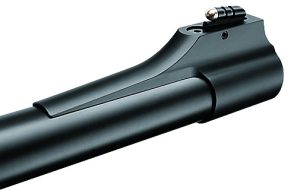 The barrel of the standard M03 Africa is 65 cm. long. I chose a barrel length of 60 cm. which makes the rifle handier. The barrels of the magnum calibres are quite heavy and strong; the muzzle diameter is 19 mm. The steel of the barrels is plasma nitrated. This means the barrels have a non-reflecting and fully rustproof surface. The sling swivel is barrel banded because a standard, forearm-mounted sling swivel is not a not a good idea for a heavy recoiling rifle. The rifle shoots very precisely.
The barrel of the standard M03 Africa is 65 cm. long. I chose a barrel length of 60 cm. which makes the rifle handier. The barrels of the magnum calibres are quite heavy and strong; the muzzle diameter is 19 mm. The steel of the barrels is plasma nitrated. This means the barrels have a non-reflecting and fully rustproof surface. The sling swivel is barrel banded because a standard, forearm-mounted sling swivel is not a not a good idea for a heavy recoiling rifle. The rifle shoots very precisely.
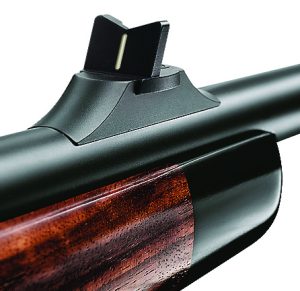
The rear sight is sideways adjustable. The M03 has a barrel banded pearl cupro nickel front sight which is vertically adjustable.
The M03 has a very fast lock time, faster than Model 98 locks. The trigger has a
clear crisp shotgun type release. A set trigger is available as option. I myself hate set triggers; I don’t need them and I feel that they are an abomination on a big game rifle.
Scope Mount
The M03 features a so-called double square bridge with integral scope mount bases.
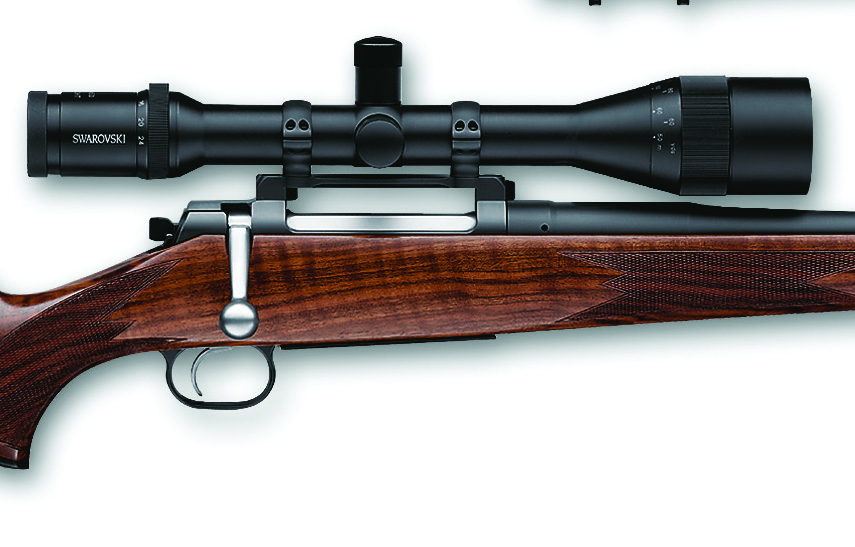
I have installed a Leupold 1, 5 – 5 x 20 on my M03. I am using this type of Leupold scopes on all my big bore rifles. The eye relief on these scopes is very long which helps to avoid a “Weatherby eyebrow”. Leupold scopes are very robust and shock-resistant and have never let me down during my African hunts. Walking through the bush I usually set the scope at a 1,5 magnification. This allows me to pick up game quickly, should the situation require this.
Rifle Weight and Kickstop
The rifle without cartridges and without scope weighs 4, 3 kg (approximately 9 ¾ pounds.) This weight may not seem much for a big-bore rifle. But with five cartridges and the scope mounted total weight goes up to nearly 4,9 kg (ca 10,8 pounds). That is a weight that I can carry for longer times without get ting overly tired. The rifle’s weight together with a so-called “kickstop” installed in the stock which dampens recoil sufficiently. The kickstop is a kind of pipe loosely filled with tungsten powder.
Loading data for the .458 Lott
When I started using a .458 Lott it was very difficult to find a proof house that owned a .458 Lott barrel. Then with the help of a friend I contacted the Vienna government proof house.
This proof house in later years performed the CIP standardization and was very helpful in testing my ammunition. (If you want to contact them: Phone: ++431-7346268; ask for Mr. Hallusch, he is the specialist for the Lott)
All the loads shown below were tested by Mr. Hallusch and released according to § 15, Abs. 2 of the Austrian proof law. All tests were performed with a 65 cm test barrel. Of course in my 60 cm barrel the muzzle velocity is a few meter/sec lower.
Bullet: 500 grains Woodleigh FMJ
- Primer: Federal 215
- Powder: 88, 0 grains Kemira N540
- Avg. V (0): 693 meter/sec
- Avg. Pressure: 4107 bar
Bullet: 500 grains Hornady Soft nose
- Primer: Federal 215
- Powder: 89, 0 grains Kemira N540
- Avg. V (0): 703 meter/sec
- Avg. Pressure: 4006 bar
Bullet: 400 grains Woodleigh PP
- Primer: Federal 215
- Powder: 92, 0 grains Kemira N540
- Avg. V (0): 750 meter/sec
- Avg. Pressure: 3638 bar
Kemira N540 seems to temperature stable. I never had any problems with these loads due to African temperatures.
WARNING – Hand loading is potentially dangerous – The loading data contained in this article is offered as a reference only, and relates to individual weapons. While it may be safe in one weapon, it may not be in others. Neither African Expedition Magazine, nor the author or Vieranas Safaris are responsible for the use or abuse of this data, or the consequences thereof.

